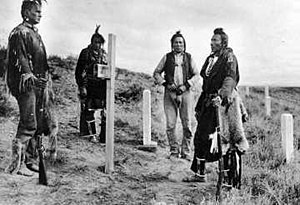Crow scouts
| Crow Scouts | |
|---|---|

Crow scouts visiting the Little Bighorn battlefield, circa 1913. From left to right; White Man Runs Him, Hairy Moccasin, Curly and Goes Ahead.
|
|
| Active | 1876 - 1877 |
| Allegiance |
|
| Branch | United States Army |
| Type | Indian scouts |
| Engagements | |
| Commanders | |
| Notable commanders |
George A. Custer |
Crow Scouts were first used by the United States Army in 1876 during the Great Sioux War. Because the Crow tribe was generally peaceful with the Americans, the army was able to enlist Crow warriors to help track Native Americans they perceived to be hostile. A small group of Crow scouts witnessed General George A. Custer's defeat at the Battle of the Little Bighorn and later some former scouts fought in the Crow War of 1887.
In April 1876 the small Crow tribe was living under army control at the Crow Agency in Montana. The Sioux and Cheyenne were traditional enemies of the Crow so at the beginning of the Great Sioux War, several Crow warriors enlisted to guide Custer's expedition to the Little Bighorn River. Six Crow scouts and thirty-nine Arikara scouts witnessed the Battle of the Little Big Horn, from June 25 to 26. Custer, leading over 500 men, intended to crush at least 900 encamped Cheyenne, Sioux and Arapaho warriors by delivering a three-pronged assault but ultimately the Americans were repulsed, leading to the deaths of over 250 soldiers. Four of the scouts, Curly, Goes Ahead, Hairy Moccasin and White Man Runs Him rode with Custer's column while two others, Half Yellow Face and White Swan, rode with Major Marcus Reno. Custer's scouts were relieved just before the beginning of the main battle because they changed out of their blue uniforms and put on their tribal wear. The scouts angered Custer and said they wanted to die like warriors, not as soldiers. Seventeen-year-old Curly refused to leave though but through the insistence of Mitch Bouyer, a mixed-blood French and Lakota guide, the young man was convinced to depart with the other three scouts. Curly watched the fight through a spy glass, from the top of a ridge, about a mile and a half away from the battlefield. When the fighting was over he eluded Sioux horsemen for two days until finally reaching the steamboat Far West at the confluence of the Little Bighorn and Bighorn Rivers. Using sign language, Curly was able to communicate the first report of Custer's defeat.
...
Wikipedia
